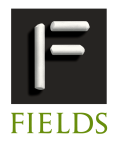January 25 - CRM Distinguished Lecture
Place
UOttawa, FTX 147A
Time
4:00pm
Speaker
Vyacheslav Futorny
University of Sao-Paolo, Brazil
Title
Gelfand-Tsetlin Theory
Abstract
We will address the representation theory of Galois algebras, family of associative algebras which have certain invariant skew group ring structure. Examples include generalized Weyl algebras, universal enveloping algebras of sl(n), finite W-algebras of type A etc. We will focus on the combinatorics of their Gelfand-Tsetlin representations based on recent joint results with D.Grantcharov, L.E.Ramirez, P.Zadunaisky and J.Zhang.
March 1 - Joint Colloquium
Place
Carleton U, HP 4351
Time
3:30pm
Speaker
Vladimir Shpilrain
City College of New York
Title
Tropical cryptography
Abstract
We employ tropical algebras (a.k.a. min-plus algebras) as platforms
for several cryptographic schemes by mimicking some well-known "classical"
schemes in the "tropical" setting. What it means is that we replace the
usual
operations of addition and multiplication by the operations min(x,y) and x+y,
respectively. An obvious advantage of using tropical algebras as
platforms is
unparalleled efficiency because in tropical schemes, one does not have to
perform any multiplications of numbers since tropical multiplication is
the
usual addition.
This is joint work with Dima Grigoriev.
Short Bio:
Vladimir Shpilrain is a professor at the City College of New York. While his
research interests embrace a variety of areas, from combinatorial group
theory
to affine algebraic geometry to complexity of algorithms, lately his research
has been focusing on post-quantum cryptography. Professor Shpilrain has
co-authored books and holds patents in that area.
For more information please contact Inna Bumagin.
March 22 - CRM Colloquium
Place
UOttawa, STEM 201
Time
4:00pm
Speaker
Eric Klassen
Florida State University
Title
Elastic Shape Analysis
Abstract
Abstract: We define a “shape” to be an equivalence class of immersed submanifolds of R^n, after modding out by isometries of R^n and reparametrizations of the submanifold. We discuss several ways of putting a Riemannian metric on the space of shapes. Such a Riemannian metric provides a unified way of answering several basic questions:
* How can we quantify the difference between two shapes?
* Registration: given two shapes, what is the optimal correspondence between their points for purposes of comparison?
* What is the optimal deformation between two shapes?
* Given a collection of shapes, can we define a sensible notion of “average shape”?
* Once we have the average, can we do principal component analysis on a collection of shapes?
We will see explicit examples of this analysis as applied to curves and surfaces.
March 29 - CRM Colloquium
Place
UOttawa, STEM 201
Time
4:00pm
Speaker
Andrew Lewis
Queens University
Title
How to use topology to make basic ordinary differential equations complicated, and also make hard differential equations easy
Abstract
This talk is about a subject about which a great deal is known: the existence, uniqueness, and regularity of solutions of ordinary differential equations. The differential equations of interest are time-varying with very irregular (measurable) time-dependence and very regular (analytic) dependence on state. For such equations, one wants a theory ensuring that dependence on initial conditions is as regular as that of the differential equation on state. It turns out that it is not immediately obvious how to formulate the correct conditions on the right-hand side to achieve the desired regularity in initial condition. In this work, the correct conditions are formulated by topologising the set of right-hand sides and then formulating conditions in terms of this topology. As a cute byproduct, this topological machinery gives a pithy description of the classical existence, uniqueness, and regularity conditions.
June 14 - CRM Colloquium
Place
UOttawa, STEM 201
Time
1:00pm
Speaker
Dan Barbasch
Cornell University
Title
Dirac Cohomology and the Unitary Dual
Abstract
The classification of the unitary dual of a real reductive group is a central problem in the representation theory of such groups. The Dirac operator plays an important role in singling out an important subset of the unitary dual. For example, via the index theorem, work of Atiyah and Schmid classify the discrete series which are essential for the Plancherel formula. Unitary representations with nontrivial (g,K)-cohomology play an important role in the theory of automorphic forms. Dirac cohomology (introduced by Vogan) is another invariant which can be viewed as a generalization of (g,K)-cohomology. In this talk I will discuss results about the unitary representations with nontrivial Dirac cohomology.



